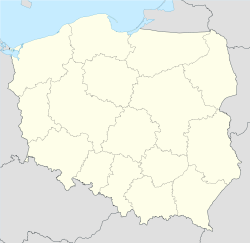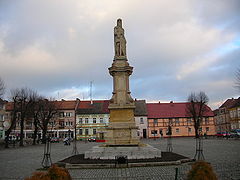- Mieszkowice
-
See also: Mieszkowice, Opole Voivodeship
Mieszkowice 
Flag
Coat of armsCoordinates: 52°47′N 14°29′E / 52.783°N 14.483°E Country  Poland
PolandVoivodeship West Pomeranian County Gryfino Gmina Mieszkowice Area - Total 4.73 km2 (1.8 sq mi) Population (2006) - Total 3,553 - Density 751.2/km2 (1,945.5/sq mi) Postal code 74-505 Website http://www.mieszkowice.pl Mieszkowice [mjɛʂkɔˈvit͡sɛ] (German: Bärwalde in der Neumark; kaschubisch: Berwôłd) is a town in Gryfino County, West Pomeranian Voivodeship in northwestern Poland, about 15 km (9.3 mi) east of the Oder river and the border with Germany. It is the administrative seat of the urban-rural gmina (municipality) of Mieszkowice.
Founded in 1298 during the Ostsiedlung in Brandenburg, the town was the site of death of the last Ascanian margrave in 1319, a center of the Waldensians movement in the 14th century, and the site of the conclusion of a Franco-Swedish alliance during the Thirty Years' War, which else virtually depopulated the town. After the war, the town slowly recovered, retaining a rural character. In the late 19th century, it was connected to the railroad, and Gottfried Benn was raised in an adjacent village. In 1945, the town largely escaped destruction, and became part of Poland. It was renamed Barwice, then Mieskowice after Mieszko I of Poland. Until 1998, Mieszkowice was part of Szczecin Voivodeship.
Contents
Name
The town now called Mieszkowice was known from its foundation until 1945 under the German name of Berenwalde and later of Bärwalde. To distinguish it from the town of Bärwalde in Pomerania (present-day Barwice), it carried the abbreviation Nm. for Neumark. In 1945 it was renamed Mieszkowice, after the first historical Polish duke Mieszko I, a scion of the Piast dynasty.
Mieszko I, after winning the 972 Battle of Cedynia against the Saxon margrave Odo I, had annexed to the early Polish state the territory on which later the town was founded.
History
The settlement was established in the 13th century, after the Ascanian margraves of Brandenburg[1] had acquired the region from the Pomeranian dukes (see Brandenburg-Pomeranian conflict). While the town was founded during the Ostsiedlung, remains of a nearby fortress indicate earlier Slavic presence in the area.[2]
The first record of Bärwalde is a 1295[1] deed under the name of Berenwalde. Most likely, the settlement was owned by a knight of the von Behr family.[1][2] The settlement was developed following a grid of rectangular streets with a central market place.[2] In 1297, St. Mary's Church was first mentioned,[3] and another document gives 1298 as the year when Bärwalde was granted German town law.[1][2] In the late 13th and early 14th century the city walls were constructed,[4] much of which still exist, while the city gates were pulled down in 1867.
In 1309, the last Ascanian margrave Waldemar died in the town.[2] Therefater, throughout the 14th century, Bärwalde was subordinated directly to the Holy Roman Emperor and the regional center to 29 surrounding villages.[2] During this period, it was strongly affected by the Waldensians (Waldenser) movement.[2] Since 1353 coins for Brandenburg's Neumark were struck at the Bärwalde mint.
In the course of the Polish–Teutonic War the town was burnt down in 1433 by Hussite forces marching through. During the Thirty Years' War, the Swedish field marshal Gustav Horn on 23 January 1631 signed the Treaty of Bärwalde with France[5] against Emperor Ferdinand II of Habsburg, whereafter the town was devastated by Swedish and Imperial troops several times. The devastations of the war resulted in a severe population drop: only 30 inhabitants remained.[5] From 1650-73 Elias Loccelius, also known as Elias Lockelius or Löckel, (1621–1704) was pastor in Bärwalde and from there he moved to Drossen (today Ośno Lubuskie). He is known as a chronicler of the Neumark and was an electoral church inspector for Land Sternberg as well. Löckel documented the wartime devastation of the area, including Bärwalde, in his Marchia Illustrata.[5]
Over the next centuries, the town slowly recovered: in 1750, Bärwalde had about 1,500 inhabitants, and more than 3,500 in 1850, occupied primarily with agriculture.[5] From that period, several 18th-century Fachwerk buildings and the early 19th-century town hall are preserved.[3] When the Kingdom of Prussia reformed her administrative organization after the Napoleonic Wars, Bärwalde became part of the Province of Brandenburg created from the territory of the former margraviate. In 1853 a railroad connected Bärwalde with Kostschin (now Kostrzyn). Twenty-three years later the town was connected with Stettin (now Szczecin). Gottfried Benn (1886–1956) spent his childhood in the nearby village Sellin (now Zielin).[6]
Bärwalde was captured in 1945 by the Red Army during the Vistula–Oder Offensive in the final period of World War II, and as it was east of the Oder-Neisse line, became part of Poland. Only 30% of the town were destroyed.[7] The remaining inhabitants were expelled and the town was resettled by Poles, including settlers from Central Poland and expellees from former Eastern Poland (Kresy).[4] Bärwalde was first renamed Barwice, later Mieszkowice after Miesko I of Poland.[8] The final name was chosen for political purposes: the Communist regime sought to legitimize its presence at the Oder by referring to the medieval Piast dynasty, whose territory had also extended to the Oder, and propagated the "return" to ancient Polish lands.[4] To that effect, a legend was popularized in Mieszkowice, linking the town's foundation to a hunting expedition of Mieszko I: Allegedly, the town was founded at a spot where Mieszko once slew two bears.[1] In 1957, a statue of Mieszko I created by Sławomir Lewiński was unveiled on the town square.[1] It is the only monument of this ruler in all of Poland.
Development of Mieszkowice continued in the following years, especially in the period between 1970-1992 when many new buildings were constructed. In 1997 the whole town was connected to the gas pipeline. In 1998 a new sport centre was opened. Since 2007, a ferry service connects Mieskowice with Güstebieser Loose on the opposite bank of the Oder.[7]
Twin town
 Wriezen, Germany
Wriezen, Germany
Sources
- References
- Bibliography
- Lüderitz, Jörg (2008) (in German). Die Neumark. (4 ed.). Trescher Verlag. ISBN 3897941228.
- Owczarek, Małgorzata (2008). "Der piastische Gründungsmythos am Beispiel von Mieszkowice (Bärwalde)". In Bernd Vogenbeck (in German). Terra Transoderana. Zwischen Neumark und Ziema Lubuska. Almanach. Berlin: be.bra Wissenschaftsverlag. pp. 86–91. ISBN 978-3-937233-50.
External links
Coordinates: 52°47′N 14°29′E / 52.783°N 14.483°E
Town and seat Mieszkowice
Villages Categories:- Cities and towns in West Pomeranian Voivodeship
- Gryfino County
Wikimedia Foundation. 2010.



